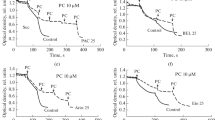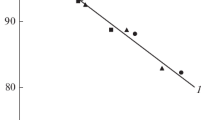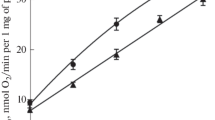Abstract
Mitochondrial β-oxidation is an important system involved in the energy production of various cells. In this system, the function of l-carnitine is essential for the uptake of fatty acids to mitochondria. However, it is unclear whether or not endogenous respiration, ADP-induced O2 consumption without substrates, is caused by l-carnitine treatment. In this study, we investigated whether l-carnitine is essential to the β-oxidation of quarried fatty acids from the mitochondrial membrane by phospholipase A2 (PLA2) using isolated mitochondria from the liver of rats. Intact mitochondria were incubated in a medium containing Pi, CoA and l-carnitine. The effect of l-carnitine treatment on ADP-induced mitochondrial respiration was observed without exogenous respiratory substrate. Increase in mitochondrial respiration was induced by treatment with l-carnitine in a concentration-dependent manner. Treatment with rotenone, a complex I blocker, completely inhibited ADP-induced oxygen consumption even in the presence of l-carnitine. Moreover, the l-carnitine dependent ADP-induced mitochondrial oxygen consumption did not increase when PLA2 inhibitors were treated before ADP treatment. The l-carnitine-dependent ADP-induced oxygen consumption did contribute to ATP productions but not heat generation via an uncoupling system. These results suggest that l-carnitine might be essential to the β-oxidation of quarried fatty acids from the mitochondrial membrane by PLA2.






Similar content being viewed by others
Abbreviations
- CPT-I:
-
Carnitine palmitoyl transferase I
- OCTN2:
-
Organic cation/carnitine transporter 2
- PLA2 :
-
Phospholipase A2
- CoA:
-
Coenzyme A
- HPG:
-
4-Hydroxy-l-phenylglycine
- BPB:
-
Bromophenacylbromide
- MFA:
-
Mefenamic acid
- AA:
-
Aristolochic acid
- EGTA:
-
Ethylene glycol tetraacetic acid
- RCR:
-
Ratio of respiratory control
- BSA:
-
Bovine serum albumin
- iPLA2 :
-
Ca2+-independent PLA2
References
Bremer J (1983) Carnitine—metabolism and functions. Physiol Rev 63:1420–1480
Li MX, Yoshida G, Horiuchi M, Kobayashi K, Saheki T (2006) Prolonged effect of single carnitine administration on fasted carnitine-deficient JVS mice regarding their locomotor activity and energy expenditure. Biochim Biophys Acta 1761:1191–1199
Kerner J, Parland WK, Minkler PE, Hoppel CL (2008) Rat liver mitochondrial carnitine palmitoyltransferase-I, hepatic carnitine, and malonyl-CoA: effect of starvation. Arch Physiol Biochem 114:161–170
Oyanagi E, Yano H, Kato Y, Fujita H, Utsumi K, Sasaki J (2008) l-carnitine suppresses oleic acid-induced membrane permeability transition of mitochondria. Cell Biochem Funct 26:778–786. doi:10.1002/cbf.1506
Kim JS, Southard JH (2000) Effect of phospholipase A2 inhibitors on the release of arachidonic acid and cell viability in cold-stored hepatocytes. Cryobiology 40:27–35
Furuno T, Kanno T, Arita K, Asami M, Utsumi T, Doi Y, Inoue M, Utsumi K (2001) Roles of long chain fatty acids and carnitine in mitochondrial membrane permeability transition. Biochem Pharmacol 62:1037–1046. doi:10.1016/S0006-2952(01)00745-6
Reda E, D’Iddio S, Nicolai R, Benatti P, Calvani M (2003) The carnitine system and body composition. Acta Diabetol 40:S106–S113. doi:10.1007/s00592-003-0040-z
Javadov S, Karmazn M (2007) Mitochondrial permeability transition pore opening as an endpoint to initiate cell death and as a putative target for cardioprotection. Cell Physiol Biochem 20:1–22. doi:10.1159/000103747
Gadd ME, Broekemeier KM, Crouser ED, Kumar J, Graff G, Pfeiffer DR (2006) Mitochondrial iPLA2 activity modulates the release of cytochrome c from mitochondria and influences the permeability transition. J Biol Chem 281:6931–6939. doi:10.1074/jbc.M510845200
Arita K, Kobuchi H, Utsumi T, Takehara Y, Akiyama J, Horton AA, Utsumi K (2001) Mechanism of apoptosis in HL-60 cells induced by n-3 and n-6 polyunsaturated fatty acids. Biochem Pharmacol 62:821–828. doi:10.1016/S0006-2952(01)00723-7
Kanno T, Sato EE, Muranaka S, Fujita H, Fujuwara T, Utsumi T, Inoue M, Utsumi K (2004) Oxidative stress underlies the mechanism for Ca(2+)-induced permeability transition of mitochondria. Free Radic Res 38:27–35
Bradford MM (1976) A rapid and sensitive method for the quantitation of microgram quantities of protein utilizing the principle of protein-dye binding. Anal Biochem 72:248–254
Nishimura M, Okimura Y, Fujita H, Yano H, Lee J, Suzaki E, Inoue M, Utsumi K, Sasaki J (2008) Mechanism of 3-nitropropionic acid-induced membrane permeability transition of isolated mitochondria and its suppression by l-carnitine. Cell Biochem Funct 26:881–891. doi:10.1002/cbf.1521
Bielefeld DR, Vary TC, Neely JR (1985) Inhibition of carnitine palmitoyl-CoA transferase activity and fatty acid oxidation by lactate and oxfenicine in cardiac muscle. J Mol Cell Cardiol 17:619–625. doi:10.1016/S0022-2828(85)80030-4
Murthy MSR, Pande SV (1987) Malonyl-CoA binding site and the overt carnitine palmitoyltransferase activity reside on the opposite sides of the outer mitochondrial membrane. Proc Natl Acad Sci USA 84:378–382
Fraser F, Zammit VA (1998) Enrichment of carnitine palmitoyltransferases I and II in the contact sites of rat liver mitochondria. Biochem J 329:225–229
Fraser F, Padovese R, Zammit VA (2001) Distinct kinetics of carnitine palmitoyltransferase I in contact sites and outer membranes of rat liver mitochondria. J Biol Chem 276:20182–20185. doi:10.1074/jbc.M101078200
Dlasková A, Hlavatá L, Jezek J, Jezek P (2008) Mitochondrial complex I superoxide production is attenuated by uncoupling. Int J Biochem Cell Biol 40:2098–2109
Chan SH, Higgins E Jr (1978) Uncoupling activity of endogenous free fatty acids in rat liver mitochondria. Can J Biochem 56:111–116
Pfeiffer DR, Schmid PC, Beatrice MC, Schmid HH (1979) Intramitochondrial phospholipase activity and the effects of Ca2+ plus N-ethylmaleimide on mitochondrial function. J Biol Chem 254:11485–11494
Birkett DJ, Myers SP, Sudlow G (1978) The fatty acid content and drug binding characteristics of commercial albumin preparations. Clin Chim Acta 85:253–258
Bonney RC, Qizilbash ST, Franks S (1988) Inhibition of phospholipase A2 isoenzymes in human endometrium by mefenamic acid and indomethacin: modulation by calcium ions. J Endocrinol 119:141–145. doi:10.1677/joe.0.1190141
Ghosh M, Loper R, Gelb MH, Leslie CC (2006) Identification of the expressed form of human cytosolic phospholipase A2beta (cPLA2beta): cPLA2beta3 is a novel variant localized to mitochondria and early endosomes. J Biol Chem 281:16615–16624. doi:10.1074/jbc.M601770200
Tucker DE, Stewart A, Nallan L, Bendale P, Ghomashchi F, Gelb MH, Leslie CC (2005) Group IVC cytosolic phospholipase A2γ is farnesylated and palmitoylated in mammalian cells. J Lipid Res 46:2122–2133. doi:10.1194/jlr.M500230-JLR200
Kinsey GR, McHowat J, Patrick KS, Schnellmann RG (2007) Role of Ca2+-independent phospholipase A2γ in Ca2+-induced mitochondrial permeability transition. J Pharmacol Exp Ther 321:707–715. doi:10.1124/jpet107.119545
Williams SD, Gottlieb RA (2002) Inhibition of mitochondrial calcium-independent phospholipase A2 (iPLA2) attenuates mitochondrial phospholipid loss and is cardioprotective. Biochem J 362:23–32
Nishihara Y, Utsumi K (1987) 4-Chloro-4′-biphenylol as an uncoupler and an inhibitor of mitochondrial oxidative phosphorylation. Biochem Pharmacol 36:3453–3457
Acknowledgements
This study was supported by a Grant-in-Aid for Scientific Research from the Ministry of Education, Science, Sports and Culture of Japan (C-#2100700).
Author information
Authors and Affiliations
Corresponding author
Rights and permissions
About this article
Cite this article
Yano, H., Oyanagi, E., Kato, Y. et al. l-Carnitine is essential to β-oxidation of quarried fatty acid from mitochondrial membrane by PLA2. Mol Cell Biochem 342, 95–100 (2010). https://doi.org/10.1007/s11010-010-0472-z
Received:
Accepted:
Published:
Issue Date:
DOI: https://doi.org/10.1007/s11010-010-0472-z




